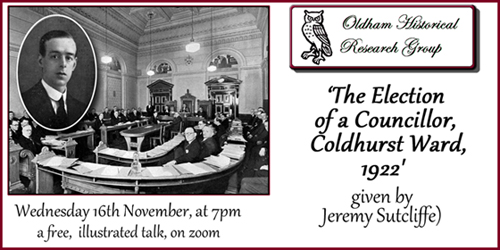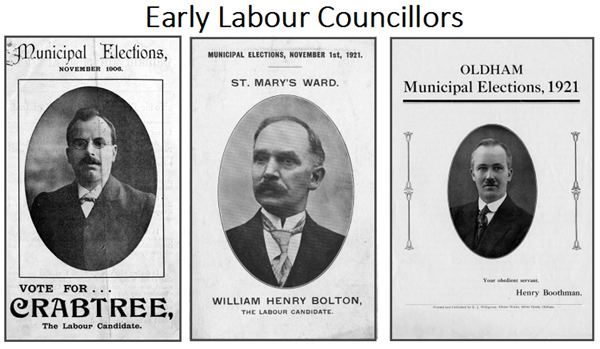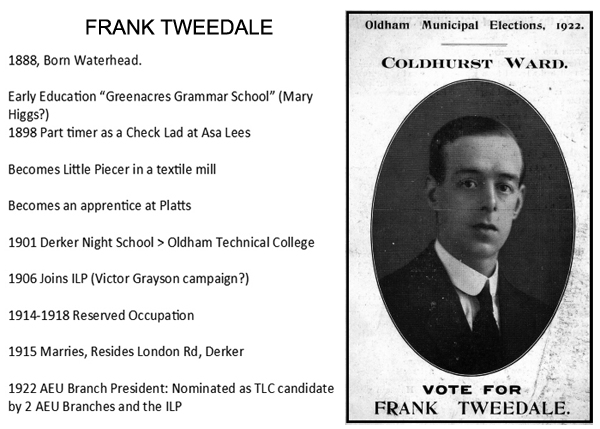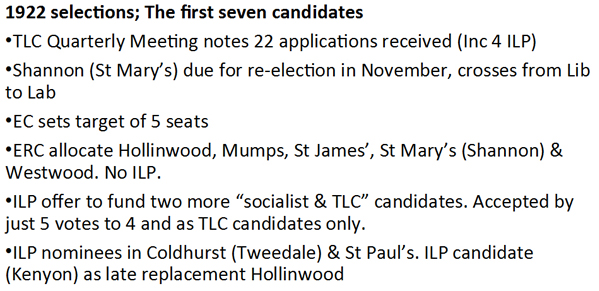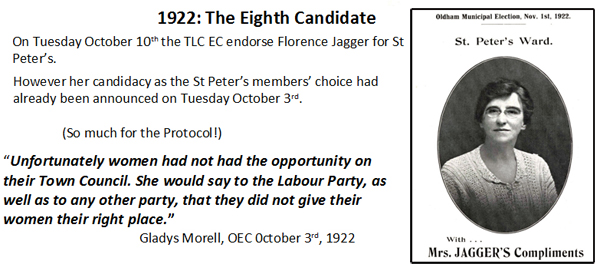
'The Election of a Councillor, Coldhurst Ward, 1922'. from an illustrated presentation given by Jeremy Sutcliffe Part 1 Introduction In 1921 the Oldham Trades and Labour Council had enjoyed its best year to date in the November municipal elections, contesting more seats than ever before. It had retained Sam Frith's seat in Westwood and had gained both Billy Bolton in St Mary's and Henry Boothman in St.Paul's (1) This brought its strength on Council to four out of the forty eight seats, the other Labour member being Isaac Crabtree, a St. Mary's councillor since 1919. (2)
Note that at this time, Oldham Council was comprised of 36 councillors representing 12 wards, elected by thirds on a three year cycle, and 12 aldermen appointed politically pro-rata from sitting councilors for a six year term with by-elections to replace the councillors elevated. Note also that, instead of the current practice of holding local elections on the first Thursday in May, in these years local elections fell on November 1st, irrespective of day unless it was a Sunday when the date would be the 2nd. Labour's temerity in contesting as many as eight out of the twelve of the County Borough's wards for the first time had provoked the local Liberal and Conservative parties into agreeing an electoral pact to ensure that the anti-Labour/anti-socialist vote would not be split. (3) This had been only partially implemented in 1921 and Boothman's victory in St.Paul's was the result of a tight three-way contest in which he only polled 37% of the vote. 1922 was to be the year that the Trades and Labour Council faced the problem of this electoral pact, in full, for its council candidates for the first time. However this external political challenge was not the only difficulty the Trades and Labour Council was facing. Internally there were clear tensions between the traditional Trade Union element and both the clearly socialist Independent Labour Party (ILP) and the individual Labour Party members' ward organizations. Individual Labour party membership and ward organisations had been instigated by the Labour Party in the constitution adopted only as recently as 1918. Previously membership was through membership of an affiliated Trade Union or Socialist Society (such as the ILP) The purpose of this study is to examine both this internal conflict, with particular regard to candidate selection, and the external situation in the municipal elections of November 1922 with particular reference to the contest in Coldhurst Ward which reflects aspects of both the difficulties and was to be the only ward actually won by Labour in 1922. Part 2 Internal Rumblings First of all it is helpful to describe the procedures for the selection of candidates for the municipal elections which had been agreed by the Oldham Trades and Labour Council in August 1920 and which would be quite alien to a member of the current Labour Party, who is more likely to he familiar with ward organisation based selections, with eligibility for participation for all members of six months standing.
The 1920 decision established an Electoral Representation Committee (ERC) comprising the Executive Committee (EC) of the Trades and Labour Council (TLC), one member from each ward organisation and four women from the individual members. The EC was to retain its previous control of finance and the right to determine the number of wards to be fought. The ERC was to determine which wards were to be contested and to place appropriate candidates in those wards. Thereafter it had the power to organise the ward organisation in the elections. Candidates were to be selected from nominations from trades unions, ward parties and other affiliated organisations, invited six, months in advance. In addition the ERC had the right to approach "other persons associated with the Labour Party who might prove suitable candidates," Councillor Sam Frith, as President of the TLC, hailed the procedures, on their adoption, as being democratically formed, although some delegates baulked at the right to approach "other persons" in case this became the means to shelve the nominations of affiliated organisations. Neither the TLC minutes, nor the Oldham Chronicle report, gives any indication as to either the identity of the objecting delegates or their appointing organisations, but in the light of future recorded arguments, it is not unreasonable to assume that they were either ILP or ward organisation based delegates. Before the EC opened nominations for potential candidates in accordance with the above procedures in May 1922 there are two recorded conflicts between ILP delegates and the TLC establishment. The first had been at the EC meeting of March 10th, when the EC had considered a letter from the ILP protesting at the irregular attendance of Cllr Frith, as President, at TLC meetings. By a vote of nine to three the EC accepted the President's explanations for his absences. The second was more substantial, and as it occurred at a quarterly delegates meeting of the TLC it was reported in the Oldham Chronicle, which in those days was present at TLC delegate meetings although not at the EC. The issue concerned the acceptance of a mayoral agreement by the Labour councillors in conjunction with their Conservative and Liberal colleagues. Such mayoral agreements were an accepted council practice. In them it was agreed which political party would provide the mayor for each of the next few years ahead and they included a courtesy convention that incoming and retiring mayors should be unopposed should they be due for re-election both immediately prior to their mayoralty or immediately following their year in office. The matter was referred to in an E.C. recommendation to the TLC and an attempt to refer it back by ILP delegates led to an acrimonious debate, Politically the ILP argument was that the agreement prevented Labour from fighting presumably winnable seats if the incoming/outgoing mayor was the retiring councillor. One delegate suggested specifically that the"trades unions were not paying specific attention to the political outlook" in surrendering the opportunity to fight the seat. The seconder of the resolution to reference back the resolution, who was identified by the Chronicle as an ILP member although not named, had introduced personality arguments by suggesting the acceptance of the mayoral agreement owed much to the ambition of Labour councilors who might wish to be mayor. This drew a sharp rebuke from Sam Frith (who would become Oldham's first Labour mayor is a result of the agreement). He rejected the insinuation and later commented that the issue had been raised by the ILP "where all such matters come from." He was supported by another delegate who pointed out that,"if the ILP are going to do this at every meeting if will break the Trades and Labour Council, The Unions will not stand it." He clearly resented that,"the ILP wants to lead and govern us." The comments of both Frith and the delegate suggest a well-established TLC Trade Union establishment/ILP socialist enmity. The establishment however had a solid majority on the TLC and the reference back was heavily defeated. The list of nominations received for consultation as candidates for the November elections was announced at the quarterly delegates meeting of the TLC on August 1st. Twenty-two individuals had been nominated, some by more than one organisation. Frank Tweedale, for example, had been nominated by both the AEU's number 4 and number 10 branches as well as by the ILP. The trade unions endorsed twenty of the candidates, the ILP four and the ward organisations six. The ILP nominations were a Mr. Dawson, Frank Kenyon, Smith M. Slater and Frank Tweedale.
The number of nominations indicated greater interest than the previous year, when only fifteen nominations had been made and from which list seven nominees had withdrawn before the ERC had made its allocations to the eight wards to he fought. It also meant that the task facing the ERC would be more controversial with a greater number of aspirants and the EC's declared intention of contesting only five seats. Before the ERC could meet to choose wards to fight and to allocate candidates, the situation was further complicated by the announcement of the Liberals' St Mary's councillor, John Shannon, that he "Beg[ged] to tender [his] resignation as a member of the Liberal Party from October 31st 1922 as [he] intend[ed] to contest the ward in the Labour interest. The minutes of the TLC give no indications to whether this was intended or expected, although Shannon's confidence in expecting to stand as a Labour candidate suggests some pre-discussion had taken place. Regrettably there is no comment about this in either of the local papers. The announcement coincided with a strike in the newspaper world and the two Oldham papers had temporarily put aside their rivalry to find enough non-striking labour to produce one paper although reduced in size and content. There appears to be no overt suggestion that Shannon intended to cross the floor because Labour had enjoyed a run of success in St.Mary's by winning a by-election in 1919 and then subsequently both the 1920 and 1921 municipal elections and subsequently taking the Poor Law Guardian's seat in the ward as recently as April 1922. During his subsequent election campaign he was to explain his conversion as "a matter of conscience", although needless to say, his opponents were to accuse him of expediency. The ERC met to select wards to be contested and to allocate candidates on August 22nd. It was preceded immediately by a meeting of the EC which made a strong recommendation that only five wards should be contested because of the serious financial position. In May they had sought permission to vary this figure up or down as circumstances permitted but now a general election was in the offing, and finding the funding for the parliamentary candidate was a grave concern. As to how close the debate was within the ERC, its minute books give us no clue but it accepted this limitation of five seats and made its candidate allocations. The new recruit, Shannon, was placed in St. Mary's, presumably as the committee used its powers of discretion as he had not been nominated by an appropriate organisation. Elsewhere Barker was allocated to Westwood (which had been won by Frith in 1921), and Birchenough, Finnerty and Heys were again asked to fight Hollinwood, Mumps and St.James' respectively, as they had in 1921. There must have been high hopes of gaining Mumps, which Labour had failed to take in that year's Guardians' elections by only five votes. On the other hand Mumps had been the only ward organisation not to have attended an earlier election preparation meeting called by the ERC. However, no ILP nominee had been placed in any ward, not even Slater, who had contested Clarksfield the previous year. The ILP clearly regarded this as unacceptable and wrote to the TLC EC calling for more than five wards to be contested. At a special meeting on September 18th, the EC agreed the to meet the ILP. It also had to deal with another situation that had arisen, namely the withdrawal of Birchenough as the candidate in Hollinwood. With time to the election on November 1st running out, the EC met the ILP deputation on September 24th. At the meeting the ILP put forward a demand that they be allowed to nominate two of their members as candidates. As an inducement to the EC, and being aware of the financial pressures, it offered to meet the election expenses of their candidates, but with the understanding that the ward organisations should be satisfied with the candidate and that they could stand on a Socialist and Labour ticket. This last point was too much for some EC members, who pointed out that this was against the spirit and constitution of the party. All candidates nominated by the TLC had to be designated as Labour candidates only. The ILP deputation withdrew and the EC narrowly agreed, by just five votes to four, that they would accept the two candidates of the Oldham ILP on the condition that they come under the sole discretion of the TLC "financially or otherwise."
The EC received and considered the ILP response on October 2nd. (30) The ILP was prepared to accept the conditions put down by the EC and put forward the names of Tweedale for Coldhurst and Slater for Clarksfield, the ward he had contested previously. Tweedale's designation for Coldhurst was agreed by the EC, but it recommended the re-allocation of Slater to St.Paul's. (31) Whether this decision demonstrates the EC exercising its power over the ILP, or whether it was a genuine need to meet the aspirations of St.Paul's Labour Party members, especially as Slater was a St.Paul's resident, living on Manley Rd., is a matter of speculation, but the ILP must have been well satisfied. Seven wards were now being contested and with three of the four initial ILP candidate nominees, Kenyon, Slater and Tweedale, in place as candidates. As the election campaign got underway, another late decision was made. On October 10th, only ten days before the elections, Florence Jagger, an individual members' nominee was endorsed by the EC as the candidate in St Peter's, although her public adoption meeting was reported in the Oldham Chronicle as having been held on the Tuesday previously.
With no reference to this previously in the TLC minutes, it would seem that Mrs. Jagger had taken steps to force its hand. The Chronicle report of her adoption meeting indicates that she closed her comments by saying, "Unfortunately women had not had the opportunity on their Town Council. She would say to the Labour party, as well as to any other party, that they did not give their women their right place." And so, the Oldham Trades and Labour Council, got its first female candidate for a seat on the town council, although none was to be successful until Gertrude Shannon won a seat in a by election in St Mary's in 1935. But by whatever means she had secured the nomination, the letter to the electorate in her published election address dated October 18th boasted of the unanimous endorsement of the TLC. Go to Part 3 External Squeeze |
Return to Members' Own Menu
